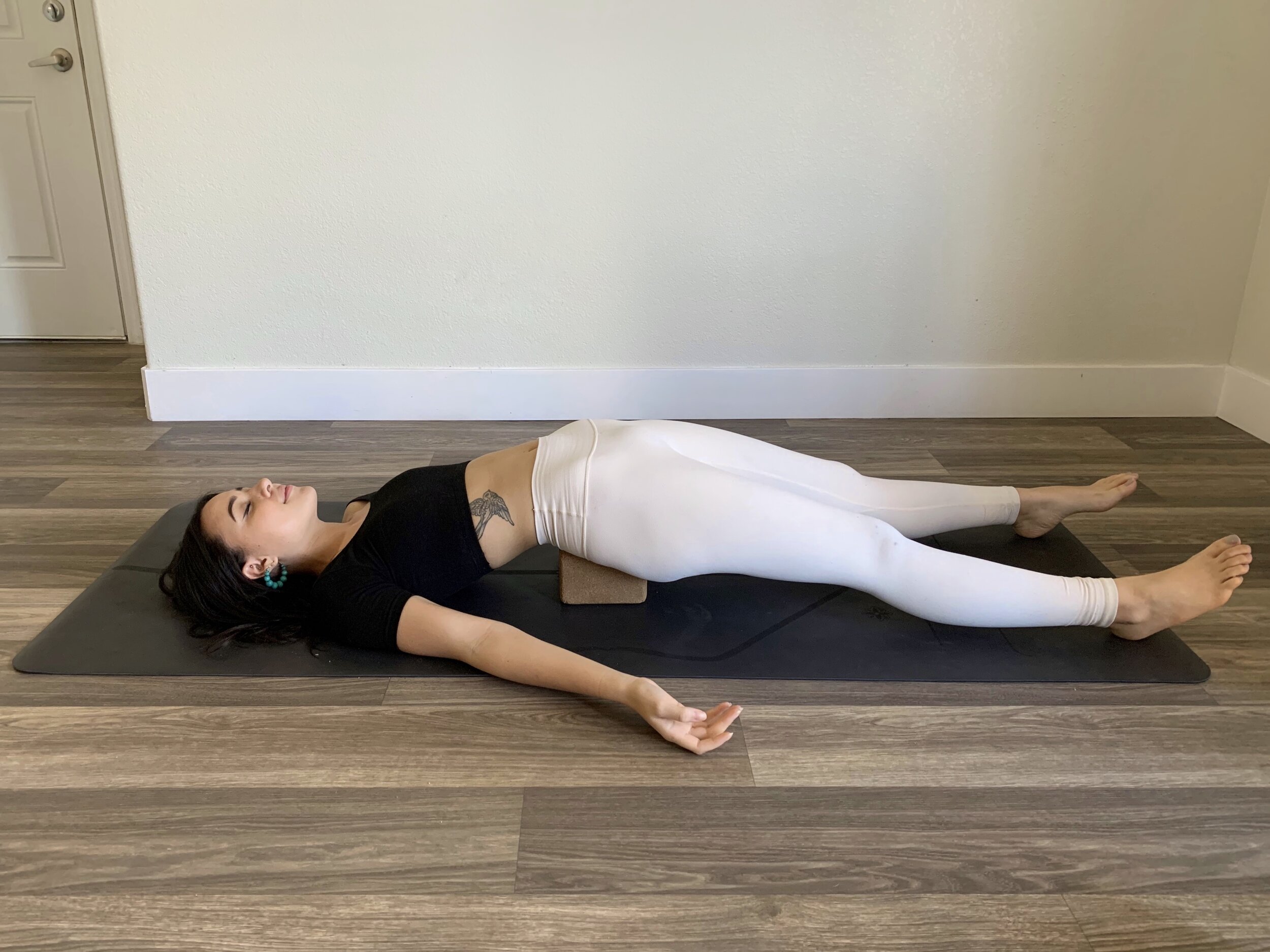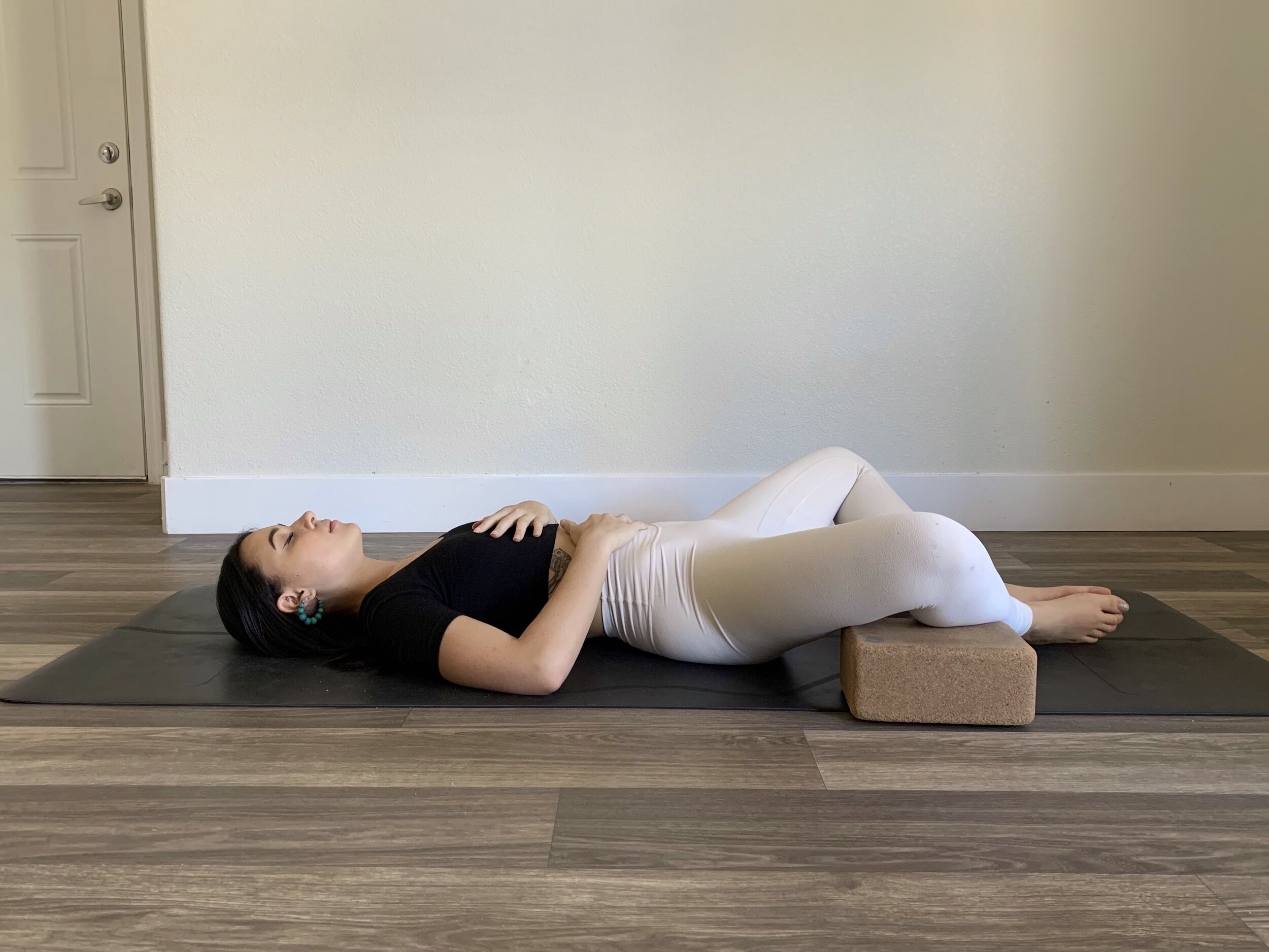Yin Yoga is a passive type of yoga geared toward maintaining the health and fluidity of the joints and balancing the body's energies. Yin Yoga is often called the yoga of the joints because unlike other styles of yoga, the emphasis is not on the muscles but on the deep connective tissue. Connective tissue is made up of fascia, ligaments and tendons which surround and form your joints.
The poses in Yin Yoga are held for an extended amount of time. Beginners can hold poses for up to one minute, but more advanced practitioners can hold poses usually 2-5 minutes, sometimes longer. It applies moderate stress to the connective tissues, improves the range of motion in your joints and also strengthens them. Although your muscles will also be stretched, that is not the focus of the practice. It is best to practice yin yoga while your muscles are cold and not warmed up, even if that sounds counterintuitive. The reason we do this is so that we can send the "stress" and the "stretch" to the connective tissues. If the muscles are warm they will steal the focus away from the joints. You can use as many props as you need to in Yin Yoga. Blocks, bolsters and straps are all great ways to support your body to make sure you are respecting your edge and not going too far.
Four main principles when practicing Yin yoga:
Find an appropriate edge: Move slowly and gently into the pose, and look for an appropriate amount of intensity, never stretch so far as to cause pain.
Stillness: consciously try to release into the pose, and to remain still, without shifting position.
Hold the position: begin by holding for 1-3 minutes gradually progressing to 5 minutes or more.
Come out of the pose gently and slowly.
In this blog post, I will cover the history, philosophy and benefits of Yin Yoga and include a video to a full 1-hour Yin Yoga class on my Youtube Channel.
Yin Yoga History and Philosophy
There are two basic types of yoga, yin and yang. Yang Yoga works our muscles and Yin Yoga works our ligaments, joints and bones. In today’s yoga culture we mainly focus on the yang. In Vinyasa, Hatha, Power, Ashtanga, etc. the main focus is our muscles. But, in order to have a balanced practice and to avoid injury, we should also be practicing Yin Yoga.
Yin Yoga is thought by some to be the oldest form of Hatha Yoga. The roots of Yin Yoga are in India and China. Ancient yoga practitioners sat in poses similar to Yin poses during their meditation. In addition to this, thousands of years ago Kung Fu practitioners were taught to hold poses for an extended amount of time while practicing various breathing techniques.
Yin Yoga takes a more meditative approach, going much deeper than the physical focal points of Yang-related practice. It is proven that as you age, your joints become less flexible. So Yin Yoga makes sure the health and flexibility are maintained.
Yin yoga poses are also designed to improve the flow of qi (or chi) the subtle energy that, according to Chinese medicine, runs through the meridian pathways of the body. It is suggested that these meridians are created by our connective tissue and that the improved flow of qi improves organ health, immunity and emotional wellbeing.
Yin Yoga in the Western World
Yin Yoga was brought to the Western world in the 1970s by Paul Grilley. His original form of Yin Yoga was called Daoist Yoga, after changing the practice to help the body energetically it became what we know of as Yin Yoga today.
Paul Grilley’s book, Yin Yoga: Principles and Practice, is a great introduction to Yin Yoga if you want to learn more about the philosophy, concepts and postures, would highly recommend this book.
Sarah Powers was a student of Paul Grilley and helped him refine the practice. She is the one how ultimately came up with the name “Yin Yoga.”
Yin Yoga Benefits
There are many contraindications (including pregnancy) for yoga poses, which is why consulting your doctor before practicing yoga is essential. You should also have a certified yoga teacher to learn and practice under.
Yin Yoga benefits are wide-ranging from the physical to the more subtle, energetic. It can be extremely helpful in having a balanced yoga practice.
Yin Yoga…
Increases circulation and improves flexibility
Calms and balances the mind + body
Reduces stress and anxiety
Releases fascia
Encourages deeper relaxation
Improves joint mobility
Brings balance to the organs through meridian stimulation
Hydrates tissues and muscles
Detoxifies
Reduces degeneration of tissues
Balances prana
My History with Yin
I first experienced a Yin Yoga class in my 200-hr teacher training in Charlotte. It was a requirement for students to attend a certain amount of classes offered at the studio. The Yin class was in the evening and because I had already taken a Vinyasa class that morning, I decided to try something different.
After that first class I was hooked. It was so different from what I had ever practiced before. I remember walking out of that class feeling completely blissed out, calm and balanced. It was exactly what my mind and body needed and I could tell immediately that this was something that was missing from my yoga practice.
After just one time of practicing, I could feel the Yin Yoga benefits. But once I started a regular practice, those benefits increased dramatically. The biggest benefit I feel physically is the release of tension knots in my upper back and shoulders and mentally, Yin gives me the space to slow down.
My love for Yin only grew over the years. Eventually I decided that I wanted to continue learning and studying yoga. I ended up traveling to Goa, India for a month to complete a 300-hr Vinyasa and Yin Yoga teacher training. While I was there I became a certified Yin Yoga Teacher.
10 Yin Yoga Poses and their Specific Benefits
Pontoon: release hip flexors, quads and abdomen
Reclined Butterfly: stimulates abdominal organs, stretches the inner thighs, groins and knees and helps relieve the symptoms of stress, mild depression, menstruation and menopause.
Supported Fish: expands the chest and can relieve neck and shoulder tension
Caterpillar: stresses the ligaments along the back of the spine while compressing the stomach organs, which helps aid digestion
Sphinx or Seal: helps to open the front of the body, activates the ligaments along the spine and compresses the lower spine, sacrum and region of the kidneys and the adrenal glands
Child’s Pose: aids digestion, reduces stress
Sleeping Swan: creates external rotation in the front leg, and targets the quads and hip flexors
Deer Pose: helps to rotate hips, aids digestion, helpful during menopause and pregnancy, can be beneficial for those with high blood pressure and asthma
Saddle: targets the quadriceps and maybe a mild stimulation of the abdominals especially with the arms above the head
Corpse Pose: balances the nervous system by moving away from anxiety and hyper-stimulation to this state of relaxation where digestion, the immune system and other essential systems are restored and enhanced
Yin Yoga Video
This is a 60-Minute Yin Yoga practice including all of the postures listed above.
Props needed: two blocks. Optional: one blanket & one bolster.
There will be modifications and variations offered so that all levels can practice! I hope you enjoy.
Namaste,
Jessica










